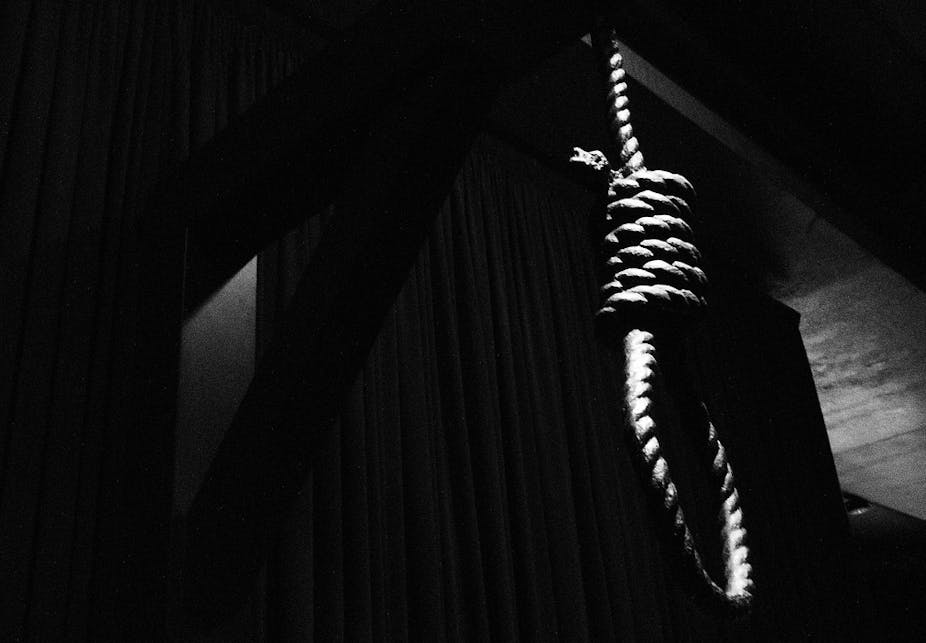Fifty years ago this Sunday, Britain passed a law which brought an end to the death penalty for murder and consigned the noose to history. One executioner, though, did not simply recede into the shadows. Albert Pierrepoint was not the last British hangman, but he was certainly the most famous. His legacy lives on as a symbol of the terrible responsibility of those charged to do the state’s killing and a benchmark for our understanding of the job.
The 1965 Murder (Abolition of Death Penalty) Act was a trial measure, with abolition finalised in 1969. But parliamentary votes on reintroduction continued into the 1990s, and it was only relatively recently that the last remnants of the death penalty were definitively removed from UK law. Only in 1998 did treason and piracy cease to be capital offences.
Bridge to the past
Pierrepoint came to embody our strange relationship with the institution. As the son and nephew of hangmen, he seemed to continue some kind of artisan family tradition. His oddly sympathetic public profile was established during the 1940s when he carried out multiple hangings of Nazi war criminals. By the time Pierrepoint had resigned from the executioners’ list in 1956 he had hanged around 450 people.

After his retirement, he dispensed expertise about hanging for television and radio audiences, acted as a film consultant and, in 1974, published a memoir, Executioner: Pierrepoint. In the post-abolition era, Pierrepoint was an authentic link with the practice of hanging; a bridge to memories of capital punishment. And there are three significant aspects in his cultural persona that have helped build our modern narrative of the executioner.
Civilised hanging
The first was Pierrepoint as an efficient and professional hangman. This was a portrayal that he contributed to in his memoir and media interviews. It stressed the meticulous care he took and emphasised his speed and efficiency. It was in keeping with 20th century understandings of execution. The bodily suffering of the condemned should be minimised or, preferably, non-existent. Whether this could actually be achieved is debatable but it was important that hanging was understood to have been “modern” and civilised.

Famously, Pierrepoint also renounced the death penalty in his memoir, stating that it achieved nothing but revenge. My trawl through the archives of the time shows that those who opposed the reintroduction of capital punishment seized on this as compelling support. This “reformed hangman” aspect of Pierrepoint’s external cultural persona earned him respect and fascination. But this appears to have been an oversimplification; statements he made in interviews I have read were more equivocal. Pierrepoint does not seem to have been firmly against capital punishment in all circumstances.
Regrets
The final aspect of Pierrepoint’s cultural persona is that of the haunted hangman, traumatised by guilt and regret. It is a noteworthy portrayal because it does not draw on his self-image. In fact, it contradicts his accounts of being untroubled about those he had hanged, even if they were subsequently pardoned.
Some press reports about Pierrepoint when he died in 1992 suggested that he was troubled by his past. However, the clearest portrayal of Pierrepoint in this way is found in the eponymous biopic. In this film, the character of Pierrepoint, played by Timothy Spall, is haunted by executing an acquaintance and, eventually, traumatised by the many hangings he has carried out. It is an appealing idea, one perhaps that the public cling to, that life is not easily taken by anyone.
Fraught future
Maybe Pierrepoint had an easy ride. Now that it is more than half a century since anyone was hanged in Britain, we can use him to understand better how this conflicting cultural persona of the executioner has contemporary relevance in the US, where the death penalty is increasingly beset by scandal.
Pierrepoint was able to construct an air of professionalism around the mechanics of the gallows, but that is not a luxury afforded to his modern-day equivalents. The availability of the drugs necessary to perform lethal injections is increasingly restricted, which has forced states that retain the death penalty to “experiment” with alternative drugs, or add other execution methods.
High-profile botched executions by lethal injection have raised the problem of how to carry out those “civilised” executions that avoid pain and suffering, and which helped to create the Pierrepoint persona in the UK. This seems almost impossible now for the Americans who try to do the same under intense scrutiny. The prospect of putting people to death in the gas chamber, electric chair or by firing squad feels like a step backwards.

In an echo of Pierrepoint’s life, some former executioners and prison governors in the US have spoken out against the death penalty. They have detailed their trauma, and campaign groups raise this potential for capital punishment to harm people other than just the condemned prisoner as an argument for abolition.
Pierrepoint would have had no truck with that, I suspect. But those somewhat contradictory narratives around his career – the quest for professionalism, his apparent reformation and the biopic tale of a man haunted by his deeds – remain deeply relevant in understanding how today’s executioners might think, and how the public might view them.

